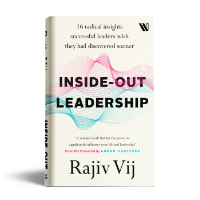
Photo by h.koppdelaney
The survival and evolution of human beings rests on their unparalleled ability to think. Descartes’ reflection, ‘I think, therefore I am’, has forever reinforced thought to be the very foundation of human existence. As humans increasingly rely on their minds, the prefrontal cortex, the thinking part of the brain, has actually grown in size and its capability.
Yet, this powerful gift does not automatically lead to gaining insights or acquiring wisdom – in fact, usually, it comes in the way. It is not the ability to think, but to consciously stop thinking, that’s most valuable. That alone paves the way for self-realization and singularly makes the human form precious.
Limitations of our thoughts
Our thinking capability is severely limited. Our thoughts are a result of our conditioned beliefs and are thus significantly restricted by our personality orientation, environment and experiences. As author Anais Nin noted, ‘We don’t see things as they are, but as we are’.
Goaded by our success with thinking through life’s mundane problems, we misconstrue that to be the most effective process of arriving at solutions. Consequently, we tend to over-think things – overlooking the fact that this approach employs merely a fraction of our mental capacity.
Besides, living in the head keeps us away from listening to our heart and engaging deeply in our relationships; the emotional noise created by our incessant mental chatter restricts us from performing at our peak potential.
The power of the subconscious
Far more powerful than our active mind is our subconscious mind. A deep reservoir of knowledge, spanning many lifetimes, it is a powerful gateway to the collective wisdom of the universe. Creating conscious moments of empty spaces between thoughts allows us to switch off from our active mind and access the subconscious. That’s what leads to new insights, peak performance and spiritual growth.
Creative people vouch for getting their most inspirational ideas in those moments. Mozart and Michelangelo have described it such. Scientists are known to find their breakthroughs during such stillness. Elite sportsmen, like Nadal, attribute their peak performance to their aptitude for shutting off all thoughts and letting the subconscious guide them.
Four ways to expand the space between thoughts
While some people have the gift, I believe, all of us can train to build such capacity. Here are four ways that can help.
1. Creating quiet time for reflection
The first step in that direction is to create quiet time for regular reflection. Most of us are so consumed by the rush of our busy lives that we fail to stop, pause and reflect. Creating conscious moments of solitude affords us the space to look within and connect with our inner wisdom. Spending time particularly in nature facilitates our slowing down and tuning in to our inner minds and the universe.
2. Trusting intuition
Secondly, we need to actively access the subconscious through our intuition – that ‘small voice of wisdom’ that resides within each of us. However, many a time, we fail to pay attention to that inner guidance. The more we trust this intuition, the more it grows – and the more it then leads us towards meaningful insights and action.
3. Staying in the present
Further, we have over sixty thousand thoughts in a day and our minds are forever traveling to the past or the future. Learning to stay focused on the present helps us relate to the potential of each moment and be detached from the instinctive preference for one outcome over the other. Letting go of our thinking mind is paramount for that.
4. Practicing mindfulness meditation
Finally, a sustained practice of meditation can take the idea of being present to a different level. Mindfulness meditation is greatly helpful in cultivating the capacity to temper our impulse to get embroiled in active thinking. Learning to merely watch our thoughts and, without judging them or getting attached to them, letting them pass away, aids us in experiencing moments of empty spaces between thoughts – those tiny moments of infinite potential.
(This is a slightly edited version of an article I had recently written for the Speaking Tree supplement of The Times of India)











 Stop Judging, Start Loving!
Stop Judging, Start Loving! Discover Your IKIGAI, Create A Life
Discover Your IKIGAI, Create A Life Expressing Difficult Emotions
Expressing Difficult Emotions Domination of Our Senses and Personal Mastery
Domination of Our Senses and Personal Mastery
Being an appreciator of Indian classical music, I just want to add another perspective about in-between. The beauty of music in enhanced by the composer by the simple act of inserting a pause between the notes. It’s the silence that adds the WOW moment and really not the clutter of notes.
Another perspective that I have noted from Gurbani writings of Guru Granth Sahib is that just one line in the entire Shabad is indicated with a suffix “Rahao”, which means PAUSE. There is a clear indication given to pause, so as to be able to reflect on the essence of the few words before going into the depth of the entire Shabad. This was a unique tradition of spiritual writing, which unfortunately no one bothers about in these days. The in-between moment (PAUSE) in reading the Shabad is where the realization can be evolved.
Thank you once again!
Great points Amardeep, many thanks for sharing!!
In becomming aware of who are as “being human” you must choose to contemplate the aspects that you desire, Let them go, then come back to those specifically in order for them to manifest. The “letting-go” is the all knowing presence that sends the request to the Universe. Who acts as the ultimate manager to create these aspects of your reality.
Great post!